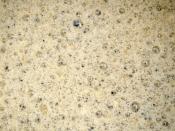Aim: To shift the azeotrope of the ethanol and water mixture in ginger beer in order to produce more potent alcohol using thermodynamics.
Hypothesis: Different temperature states during the fermentation process will produce a variety of alcohol percentages in ginger beer.
Background Research:
In the modern beer brewing process, four basic ingredients--water, malt, hops (flowers of the Humulus lupulus plant), and brewing yeast (Saccharomyces cerevisiae)--initiate myriad biological and chemical processes, including enzymatic digestion, fermentation, and isomerization, which must be harnessed to achieve a brew of predictable and consistent quality, whether it's an amber lager, pale ale, a thick porter, or a stout.
There are hundreds of types of alcohols; the standard type for wines and beers is ethyl alcohol or ethanol. Ethanol has the chemical formula C2H5OH. The production of Ethanol by fermentation of grain and fruit is one of the most effective chemical process and the oldest dating back at least 5500 years.
In fermentation enzymes in yeast causes the breakdown of all starches to glucose and then to ethanol plus carbon dioxide.
C6H1206 2C2H5OH + 2CO2
Glucose ethanol carbon dioxide
Fermentation can proceed to about 12% alcohol. By then the action of the yeast is inhibited by the concentration of alcohol. In beer, fermentation is the act of yeast on the barley. When barley is fermented to make beer it can have a percentage of alcohol between 2-7% but it is even less in regards to ginger beer. During this action carbonic gases are given off and alcohol is produced.
Fermentation
Yeast is a micro-organism containing an enzyme which will convert a sugar (glucose) solution into carbon dioxide and alcohol (ethanol).
The word equation for fermentation is
glucose + yeast carbon dioxide + ethanol.
Yeasts will undergo a three-part life cycle during the course of fermentation. In the...


